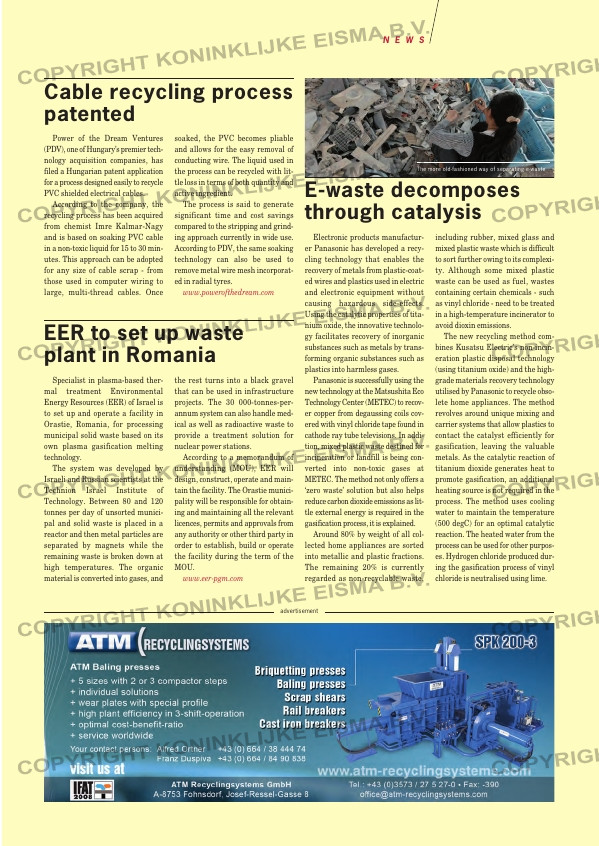Page 23 from: April 2008

Cable recycling process
patented
Power of the Dream Ventures
(PDV), one of Hungary’s premier tech-
nology acquisition companies, has
filed a Hungarian patent application
for a process designed easily to recycle
PVC shielded electrical cables.
According to the company, the
recycling process has been acquired
from chemist Imre Kalmar-Nagy
and is based on soaking PVC cable
in a non-toxic liquid for 15 to 30 min-
utes. This approach can be adopted
for any size of cable scrap – from
those used in computer wiring to
large, multi-thread cables. Once
soaked, the PVC becomes pliable
and allows for the easy removal of
conducting wire. The liquid used in
the process can be recycled with lit-
tle loss in terms of both quantity and
active ingredient.
The process is said to generate
significant time and cost savings
compared to the stripping and grind-
ing approach currently in wide use.
According to PDV, the same soaking
technology can also be used to
remove metal wire mesh incorporat-
ed in radial tyres.
www.powerofthedream.com
Electronic products manufactur-
er Panasonic has developed a recy-
cling technology that enables the
recovery of metals from plastic-coat-
ed wires and plastics used in electric
and electronic equipment without
causing hazardous side-effects.
Using the catalytic properties of tita-
nium oxide, the innovative technolo-
gy facilitates recovery of inorganic
substances such as metals by trans-
forming organic substances such as
plastics into harmless gases.
Panasonic is successfully using the
new technology at the Matsushita Eco
Technology Center (METEC) to recov-
er copper from degaussing coils cov-
ered with vinyl chloride tape found in
cathode ray tube televisions. In addi-
tion, mixed plastic waste destined for
incineration or landfill is being con-
verted into non-toxic gases at
METEC. The method not only offers a
‘zero waste’ solution but also helps
reduce carbon dioxide emissions as lit-
tle external energy is required in the
gasification process, it is explained.
Around 80% by weight of all col-
lected home appliances are sorted
into metallic and plastic fractions.
The remaining 20% is currently
regarded as non-recyclable waste,
including rubber, mixed glass and
mixed plastic waste which is difficult
to sort further owing to its complexi-
ty. Although some mixed plastic
waste can be used as fuel, wastes
containing certain chemicals – such
as vinyl chloride – need to be treated
in a high-temperature incinerator to
avoid dioxin emissions.
The new recycling method com-
bines Kusatsu Electric’s non-incin-
eration plastic disposal technology
(using titanium oxide) and the high-
grade materials recovery technology
utilised by Panasonic to recycle obso-
lete home appliances. The method
revolves around unique mixing and
carrier systems that allow plastics to
contact the catalyst efficiently for
gasification, leaving the valuable
metals. As the catalytic reaction of
titanium dioxide generates heat to
promote gasification, an additional
heating source is not required in the
process. The method uses cooling
water to maintain the temperature
(500 degC) for an optimal catalytic
reaction. The heated water from the
process can be used for other purpos-
es. Hydrogen chloride produced dur-
ing the gasification process of vinyl
chloride is neutralised using lime.
The more old-fashioned way of separating e-waste
Specialist in plasma-based ther-
mal treatment Environmental
Energy Resources (EER) of Israel is
to set up and operate a facility in
Orastie, Romania, for processing
municipal solid waste based on its
own plasma gasification melting
technology.
The system was developed by
Israeli and Russian scientists at the
Technion Israel Institute of
Technology. Between 80 and 120
tonnes per day of unsorted munici-
pal and solid waste is placed in a
reactor and then metal particles are
separated by magnets while the
remaining waste is broken down at
high temperatures. The organic
material is converted into gases, and
the rest turns into a black gravel
that can be used in infrastructure
projects. The 30 000-tonnes-per-
annum system can also handle med-
ical as well as radioactive waste to
provide a treatment solution for
nuclear power stations.
According to a memorandum of
understanding (MOU), EER will
design, construct, operate and main-
tain the facility. The Orastie munici-
pality will be responsible for obtain-
ing and maintaining all the relevant
licences, permits and approvals from
any authority or other third party in
order to establish, build or operate
the facility during the term of the
MOU.
www.eer-pgm.com
EER to set up waste
plant in Romania
E-waste decomposes
through catalysis
advertisement
N E W S
RI_020 NEWS:Opmaak 1 03-04-2008 15:15 Pagina 23



